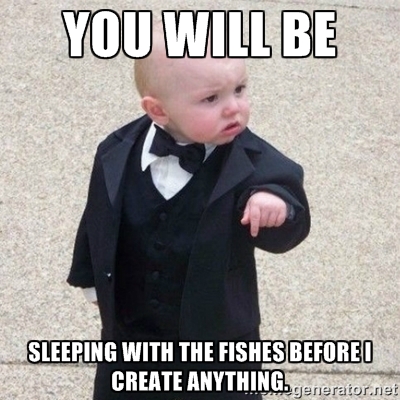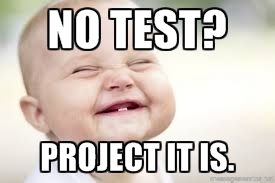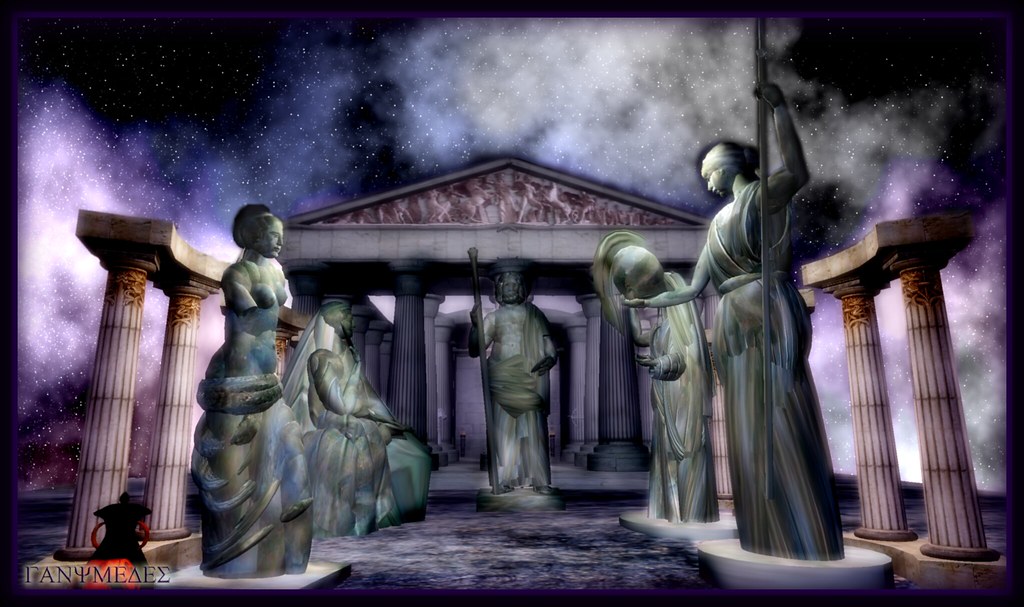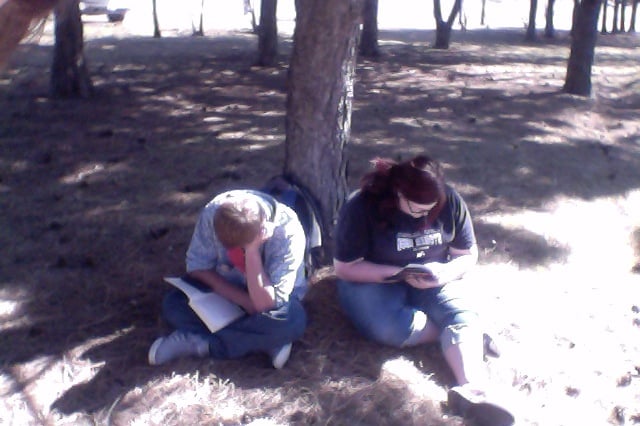One time I heard one of my third grade teachers telling one of my classmates that he was loquacious. (This was the same teacher who threw her giant textbook as hard as she could on the ground in response to her frustration with this same student, so I tended to pay attention to all of their interactions. It was one of the juiciest teacher-student relationships I had ever witnessed.) I didn’t know what loquacious meant, and I was certain it was something horrible so I looked it up. As it turns out, it means “talkative.” Not so horrible, and I remember thinking, “Well, I am NOT loquacious (in school).” I think of that teacher and that classmate every time I happen upon that word, which up until very recently was not a frequent occurrence. However, all of that changed this semester, when the word loquacious showed up as a vocabulary word for my 10th graders. I guess this is one example of why you SHOULD use big words with your own children (and students). Most students don’t want to be left in the dust, so if they don’t understand what a word means, they will ask you, or even the quiet ones (like me) will find out meaning on their own. Even if they don’t immediately, at least they will have a layer of context to work with the next time they hear the word used again.
English
The Relateable Prince Escalus
During 6th hour today, I read the part of Prince Escalus in scene 1 Act I of William Shakespeare’s Romeo and Juliet and I may have gotten into it a little too much.
It’s just that I relate to Prince E. He’s fed up with the shenanigans of his people, but when he speaks, he has trouble getting them to take him seriously, or even listen in the first place. Even with the threat of severe punishment hanging over the city, they are so wrapped up in their own affairs, they cannot be bothered to stop what they are doing to hear what he has to say. When he hears of yet another brawl stemming from the ridiculous ancient Veronian grudge, he enters the scene in a fury.
He addresses them, “Rebellious subjects!” (Everyone keeps fighting.) “Enemies to peace!” (A chicken flies past his head.) “Profaners of this neighbor-stained steel–!” (A friar gets stabbed in the eye and is wheeled out in an apple cart.) “Will they not hear?”
I mean what teacher CAN’T relate to Prince E? Maybe my students aren’t brawling in the aisles of the classroom, and so far I’ve never had a live chicken running around during class, and the consequences I lay out are nowhere near as serious as the prince’s, but we have our moments when I want to start class and everyone else in the room has other concerns. That’s normal. Students have priorities. Teachers have priorities. Those priorities don’t always match.
As the day went on, my Prince Escalus performance became more and more passionate. By 6th period, I was really feeling it. I got louder and louder. And, now my vocal cords feel broken, but I had some fun playing the role of Prince Escalus today.
the thing about creative projects …
The responses I receive when students find out we are doing a creative project are wide and varied.




5. Sometimes I think teachers (myself included) are not as creative as we could be in offering different ways of allowing students to demonstrate creativity in learning. (Confusing! And ironic!)
Questions for other educators:
What are some ways you have allowed students to demonstrate their learning creatively?
Have you ever allowed your students to go “free-range” on how they demonstrate learning? If so, what were the results?
What are some things that you’ve seen students do that might not be recognized as “creative” but are creative?
How can we tap into EVERYONE’s creativity, or at least give them a fighting chance to do so?
Instagram of the God/desses (a lesson plan, with handouts)
 Ganymedes Costagravas via Compfight
Ganymedes Costagravas via Compfight
To prep for our upcoming freshman English Odyssey unit, we are researching the gods, goddesses, and some other mythological friends. In order to avoid the boring Powerpoint/poster board format of the days of yore, my colleagues and I tapped into popular culture and asking the students to present their research in the form of a social media profile. I went the Instagram route.
My intention was to let them choose between Instagram, Facebook, or Twitter, but as the day turned into night and the night turned into morning as I worked on the Instagram template, I decided to go to bed and so #Insta it was. (I toyed with the idea of a Snapchat template, but I just couldn’t pull that one out this time. By the next time I teach The Odyssey, there will be some other social media outlet for which I will need to devise a template.) The students had the option of printing off their template and drawing “photos” by hand, or creating a digital document using Pages.
On The Danger of Books That Have Been Made Into Movies (and Potential Flim-Flammery)
The title of this blog post is a bit alarmist, especially since I was specifically speaking from an academic standpoint. Some teachers fear that students who have been assigned to read books that have been made into movies will not read and will just watch the movies instead, presumably working under the assumption that the movie is exactly the same as the book. Alarmist indeed, especially since I don’t think there is any danger in this situation, even academically speaking.
If your student hasn’t read the book, you will know. After all, you can’t flim-flam a flim-flammer … eh? I mean we were high-schoolers once. We went to college! We know all about tomfoolery, malarkey, funny business, and shenanigans. (I would’ve used another better-known saying at the beginning of this paragraph, but I like to keep this blog family-friendly … ish.) If your student hasn’t read the book, but watched the movie (or for that matter listened attentively during lectures or class discussions), s/he might be able to answer very basic content questions, but it will be nearly impossible for him/her to analyze or evaluate without being vague. This is when you can pull out your questions that pertain to the movie but not the book or vice versa … and BAM! you know you have a flim-flammer on your hands. Proceed according to your classroom policies regarding students who don’t do their work (which hopefully includes trying to get to the bottom of WHY the student is avoiding the work). Will there be the rare exception of the student who is so skilled in the art of bull-skooting that s/he will be able to dazzle her/his way through an assessment over a book s/he has not legitimately read? YES, but you don’t have supernatural powers, so there is nothing you can do about it, so let it go. As long as the student isn’t doing something to hurt her/his classmates, school property or you … for good gravy’s sake, let it go.
CONFESSION: I used to be one of those teachers who lived in fear of students poppycocking their way through a literary unit armed with only their cinematic knowledge of a piece of literature. What if they don’t read? What if they lie to me? What if they trick meeeee? What will my colleagues think of me? What will my principal think of me? Why am I so worried about me? Me? Me? Meeee? Why am I worrying about things that haven’t even happened yet and might not ever happen? Why don’t I trust kids? Why am I such a control freak? The older I get, the more I realize that, except for what I do and feel, I cannot control much else, which allows me to live in fear no more. A conversation I overheard during a lit circle discussion a day or so ago helped to solidify this and I will tell you about it, but first, a digression:
In my Contemporary Literature class, one of my goals (which is-dare I admit this publicly?–NOT ATTACHED to a state standard—GASPPPPpppp!) is to take each of my students’ stance on reading and move it closer to LOVE.
Allow me to expound visually …

Where do you fall on the Reading (the feels) Spectrum? I’m just west of considering reading as marriage material.
In other words, no matter where the a student is on the Reading (the feels) Spectrum, I want that student to be closer to LOVE when s/he walks out of my class at the end of the semester. Most kids walk into my class with a basic MERPitude toward reading. They don’t outright hate it, but it’s not something they crave. Some kids walk in somewhere between MERP and HATE. Even fewer walk in somewhere between MERP and LOVE. It is a rarity that a student is already in LOVE with reading when they walk in, but it does happen. In fact, every so often I have a student take Contemporary Literature because s/he wants to, even though s/he is already enrolled in another English class and doesn’t need the extra credit to graduate. When that happens it is a true compliment to English Language Arts–probably one of the highest.
In Contemporary Literature, (which originally was created for students who did not plan to attend a four-year college, but now has been overflowing with students of every post-high school intention imaginable … !!!) I use the following things to help move student closer to LOVE:
A. high-interest books: I do not pay attention to reading level or text-complexity. I look for well-written, interesting, books with relatable characters and topics that affect modern students. I don’t give a flying fig if it appears on some elite College Board or ACT list. I don’t care if scholars think it’s trashy, or simple, or cheesy. If it hooks a reluctant reader’s interest, I’ll take it.
B. self and group regulated activities: –like literary circles, for example. Activities like lit circles gives the students choice and independence–something that EVERYONE needs to thrive, whether they are 2 or 100. These are also elements that are too often left out of the classroom, sadly.
C. alternative texts: We dive into graphic novels, science fiction, articles from the web, podcasts, and movies. YES: Movies ARE a -visual- text.
And now back to my original topic … Sometimes books inspire students to watch movies. On the other hand, sometimes movies are the gateway drug to books. Yes indeedy: Movies can lead students to books! Sometimes a kid likes a movie so much that s/he decides to read the book. And, sometimes a kid is assigned a book that has been made into a movie, and even though the movie isn’t exactly like the book, it still helps the kid understand the book–either before the student reads or retroactively. Those are positive things!
Personally, I prefer to read a book THEN watch a movie. However, other people have different preferences. Just because that’s the way I like to do it DOESN’T MEAN EVERYONE HAS TO LIKE IT THAT WAY. (That’s hard for some teachers to grasp, I’ve noticed.) For me, once I’ve seen a movie, it’s hard for me to NOT picture the actor who played each character as I read, and I don’t like that, but not everyone has those issues. They are either able to block the actors’ images from their minds or they enjoy having a visual upon which to rest the mind’s eye.
If you choose a book to teach (or allow students to choose a book to read) that has been made into a movie, will you have a percentage of kids who will watch the movie in lieu of reading? ALWAYS. Just like you will always have a percentage of kids who “replace” reading with Wikipedia or Sparknotes or LitCharts or the next newfandangled thang that comes along under the guise of helping people understand literature but which actually serves as a means for kids (and adults) to cheat on content-level tests (and book club meetings). (In fairness to the aforementioned entities, I will say that when used with integrity, they do serve as a resource for helping people understand literature–at a surface level.) That being said, if a kid is able to pass an assessment without reading the book, are you asking the right questions? (That is for another blog post, methinks.)
Now back to that conversation I mentioned earlier in the post. During lit circles the other day, I overheard students discussion the book, The Fault In Our Stars by John Green, which is not only a popular book, but also a popular movie. The group members had all seen the movie. They were comparing the book to the movie and making note of all of the differences. They were also evaluating the movie based on the book–what they liked about the book and what they thought the movie did better. They were also qualifying WHY they felt that way. This was a grown-up conversation, and they were doing this without my guidance and without micro-management of any sort. The lit circle provides a flexible structure for the students. They build outward from that structure. It is always an honor to lead a class in discussion, but it is an even more rewarding to listen to young people do it on their own. And guess what? They held each other accountable for reading. Based on my experience, students are more motivated to be prepared when they know their peers will be upset with them than they are when they just know that the teacher might be upset. And it is one thing to attempt to bamboozle a teacher. It is another thing to attempt to hornswoggle a group of your peers. They will call you out–publicly. And they will determine whether or not you read or just watched the movie and said you read. They will ask the trick questions outright!
The movie version of The Fault in Our Stars served as another point of dialogue for the students. It did not detract from the conversation. It did not demotivate them. They still read the book. They held one another responsible. They got into higher levels of thinking (analysis, evaluation) BECAUSE they watched the movie AND read the book.
Outside of lit circles, there will be kids whose interest is sparked enough by a movie that they will read the books that inspired the movies … and they might even like reading those books … maybe even a little bit more than they enjoyed their last reading experiences. As a result, they move a little closer to LOVE!
That is a good thing. That is what teaching is all about.
Rigorrrrrrrrrr
I like what (most) educators mean when they say RIGOR (and I love even more the idea of relevance and engagement in the classroom) but truth be told, that word just makes me think of stiff corpses …
<tenting hands à la cartoon villain> … You’re thinking about them now … aren’t you? …
Unfortunately (for me and anyone like me), any time you get a bunch of dorks together to talk about curriculum the dead body word comes up, every stinkin’ time. It’s been in use for a good long while now too, so I think it’s outlived the buzzword phase. We’re probably stuck with it. However, after typing rigor into thesaurus. com, I’ve curated a brief collection of of alternatives for the aforementioned word that I would very much like to avoid, if possible, when discussing anything but the state of a cadaver from this point forward:
AUSTERITY –> After all, standards should be of a stern and unwavering nature, no? (Curriculum should not be austere; standards should be.)
FIRMNESS or RIGIDITY –> Standards should be unmoving, stationary targets. (Again: The curriculum should be fluid, adaptable, and ever-evolving to best meet and exceed standards, but the standards themselves should usually stay put–until we discover a problem. Then they should be altered immediately.)
PRECISION –> Of course standards should be clearly defined and exact–so should curriculum.
ASPERITY –> This one means harshness or sharpness, which is way worse than THE WORD THAT SHALL NOT BE NAMED’s definition, but as a word, it is much more auditorily pleasing.
TRADITIONALISM or CONVENTIONALISM –> These are, after all, qualities that curriculum and standards sometimes take on if rigor’s intended meaning is misconstrued. Maybe, if we called it one or all of these things, it could serve as a warning to people when they started getting away from academically or intellectually challenging (the definition I use for rigor) curricula to stale, inflexible, stoutly traditional or boringly conventional curricula. (There’s nothing wrong with some traditional or conventional methods, so please don’t slay me with your words, dearest readers who favor traditional or conventional methods in education. I just firmly believe that educators need to stay fresh and open to the idea that there is always a possibility of something better out there as we continually learn more about learning.) In other words, when we are dealing with a rigorous curriculum–cool. When we are dealing with a stale, unwaveringly, boring, traditional-for-the-sake-of-tradition curriculum we can say … Whoa, slow down there, doggy. We’re getting into the realm of inflexible traditionalist conventionalism and we’re going to need to shorten your leash a little.
OBDURACY –> This means unmoving, stubborn, unyielding … When you get down to it, standards should be these things, but the people who write them shouldn’t be. WE, the keepers of the curricula, have to be flexible enough to see when something that was “set in stone” needs to be sandblasted.
PUNCTILIOUSNESS –> This is my favorite. It is more in line with what I think of when I think of what curriculum and standards should be, but is also just a cool words that does not conjure up any morbid thoughts for me. It feels pleasant on the tongue and sounds lovely in the air. Punctiliousness is an attentiveness to detail. Isn’t that agreeable? Maybe even … charming? Okay … that’s probably taking it too far, but it’s a heckuva lot better than corpses … frozen, immalleable, ossified corpses. (Shut up! I’m closing out of the thesaurus.com tab right now …)
None of the words on the above list mean fun things–not that education ALWAYS has to be a circus of entertainment. (Though wouldn’t it be cool if we actually included a standard for fun? Then again, any attempt to standardize fun would probably make it less fun … so, never mind.) Education should be fun when it CAN be, but it can’t always be. Curriculum should be suitably challenging, even difficult at times (not that fun and challenge are mutually exclusive). And again, I think that rigor (gag!) as it is usually intended in curricular discussions IS a good thing. I just wish we could agree on a more palatable* way to say it.
*I thought up the word palatable without the assistance of thesaurus.com.
The Passionate (Student) Blogger
UPDATE: Here is a link to a “mock” blog I set up with instructions for my students: MRS. MORGENSON’S MOCKUP.
As an English Language Arts (ELA) teacher, I want my students to achieve at the highest level possible on district and state level goals, but ultimately, my goal is to help my students be the most effective and successful (however they personally define success) people they can be AND to help ignite a passion for reading and writing. My belief is strong: If you are an effective writer, reader, speaker and critical thinker, you can go anywhere and do anything. However, I realize that not every student I encounter is going to find passion in writing (or reading, speaking, or critical thinking), but even if they walk out of my room liking writing and/or reading MORE than they did before they met me, I am happy. (Even if they don’t LOVE it, I’m okay with that as long as they’ve moved over on the scale of LIKE.)
One way I’m trying to sneak in some extra writing this year is through a PASSION BLOG, as inspired by my Tweep Beth Still and her students. My philosophy behind this idea is that the writing will be driven by passion, thus the writing will be more palatable–even to reluctant writers.
I want my students to take ownership in this to the max, so I sent them a survey today to gauge what they found to be a reasonable expectation for these next 10ish (intense final) weeks (of their high school careers). The requirements listed below are reflective of the collective response to that survey. I was most impressed by the overwhelming majority’s desire to REQUIRE impeccable grammar. (My cup runneth over!)
—————
PASSION BLOGS
Minimum Requirements
- 1 entry per week for 10 weeks for a total of 10 entries
- (Feel free to post MORE than 10 entries, of course!)
Each entry should
- be an average of three solid paragraphs (five to six sentences each) (This means that some of your entries might be shorter than three sentences and some might be longer. Sometimes you’ll have more to say; sometimes you’ll have less.)
- be grammatically sound
- be FULL of YOUR voice, your style and interesting word choices
- be interesting to you and your readers (prove your content’s relevance)
Your entries might need to
- cite sources (if applicable)
- include links, graphics, or video (if applicable)
If you need your edublog sign-in info, please see me ASAP.
FEEL FREE TO EXCEED THE MINIMUM. ALLOW YOUR PASSION TO DRIVE THIS PROJECT!
—————–
Once we get the blogs up and running, I will post links to all of them in a post right here — on MY passion blog.
A Formative Assessment for Teaching Shakespeare (Hamlet Specifically) with Email Clarification
Yesterday, I was at some training, so I had my sub give the following assignment.
*
CHOOSE ONE PASSAGE and RESPOND accordingly to the instructions.
INSTRUCTIONS
- Pick one of the following monologues to dissect and analyze. In a formal written response capture the essence of the passage in a concise SUMMARY, and then analyze the passage through the lenses of EXPERIENCE, INTERPRETATION, and EVALUATION.
- Please write four distinct, fully-developed paragraphs, one for each of the aforementioned areas of analysis (SUMMARY, EXPERIENCE, INTERPRETATION, and EVALUATION.) Note: Your SUMMARY paragraph will most likely be your briefest one.
- Revisit your DiYanni text, if you need further guidance regarding these realms of interpretation. After reading through the DiYanni text –if needed– contact Mrs. M with further questions via email (email redacted) or in person tomorrow or Friday.
- Also, HELP EACH OTHER! Processing through dialogue is a very valuable strategy.
PASSAGE 1
Even though he is told otherwise, Hamlet suspect that his Claudius and Gertrude have sent for Rosencrantz and Guildenstern to possibly cheer him up, spy on him, or both. He finally gets them to admit this and responds thusly:
I will tell you why; so shall my anticipation
prevent your discovery, and your secrecy to the King and
queene: moult no feather. I have of late, (but wherefore
I know not) lost all my mirth, forgone all custom of exercises;
and indeed, it goes so heavily with my disposition;
that this goodly frame the earth, seems to me a sterrill
promontory; this most excellent canopy the air,
look you, this brave o’erhanging firmament, this Majesticall roofe,
fretted with golden fire: why, it appeares no other thing
to me, then a foul and pestilent congregation of vapours.
What a piece of work is a man! How noble in
reason, how infinite in faculty! in form and moving
how express and admirable! In action how like an Angel!
in apprehension how like a god! the beauty of the
world! the paragon of animals! And yet to me, what is
this quintessence of dust? Man delights not me; no,
nor Woman neither; though by your smiling you seem
to say so
PASSAGE 2
As Hamlet plans his revenge upon his new “father” King Claudius, he cannot help but contemplate his own existence. In the following speech, he weighs the ever-famous question: To be, or not to be?
To be, or not to be, that is the question:
Whether ’tis Nobler in the mind to suffer
The Slings and Arrows of outrageous Fortune,
Or to take Arms against a Sea of troubles,
And by opposing end them: to die, to sleep
No more; and by a sleep, to say we end
The Heart-ache, and the thousand Natural shocks
That Flesh is heir to? ‘Tis a consummation
Devoutly to be wished. To die to sleep,
To sleep, perchance to Dream; Aye, there’s the rub,
For in that sleep of death, what dreams may come,
When we have shuffled off this mortal coil,
Must give us pause. There’s the respect
That makes Calamity of so long life:
For who would bear the Whips and Scorns of time,
The Oppressor’s wrong, the proud man’s Contumely,
The pangs of despised Love, the Law’s delay,
The insolence of Office, and the Spurns
That patient merit of the unworthy takes,
When he himself might his Quietus make
With a bare Bodkin? Who would Fardels bear,
To grunt and sweat under a weary life,
But that the dread of something after death,
The undiscovered Country, from whose bourn
No Traveller returns, Puzzles the will,
And makes us rather bear those ills we have,
Than fly to others that we know not of.
Thus Conscience does make Cowards of us all,
And thus the Native hue of Resolution
Is sicklied o’er, with the pale cast of Thought,
And enterprises of great pitch and moment,
With this regard their Currents turn awry,
And lose the name of Action …
*
Within five minutes of class time starting, I (happily) engaged in the following email exchange with one of my students, while I was in training.
———————————————–
EMAIL FROM STUDENT
———————————————–
What do you mean write a paragraph about experience, interpretation, and evaluation? Specifically experience and evaluation cause I’m guessing by interpretation you mean tell what happened in detail.
(student name redacted)
———————————————–
MY EMAIL RESPONSE
———————————————–
Hi (student name redacted)
Thanks for asking.
EXPERIENCE–> How might you relate Shakespeare’s words to your own life? Do you agree or disagree with the message/sentiments of the passage? Why? Have you ever experienced something that reminds you of what is being expressed here? If so, tell us about it. If not, can you relate it to something else you’ve read? seen? heard from someone else?
EVALUATION–> Why do you think Shakespeare included this passage? Why is it important to the story? to the reader? or is it? Make a value judgment. Is it well-written? Is it poetic? Explain.
Hope this helps! If you have further questions, let me know.
-JM
———————————————–
EMAIL RESPONSE FROM STUDENT
———————————————–
Alright (sic) thanks. So the interpretation is just a detailed analysis of what happened right?
(student name redacted)
———————————————–
MY EMAIL RESPONSE
———————————————–
Hi again, (student name redacted)
The SUMMARY will be a brief account of what happened.
The INTERPRETATION will be where you explore the choices Shakespeare made. Did he use metaphors? similes? personification? oxymoron? etc. Why did he make these literary choices? Was there any double meaning in what he wrote? What do we know that the other characters don’t know? Who else is in the scene? How do those characters play in? Who is the intended audience? What does this passage say about Hamlet? What does it say about the culture he lives in?
You don’t necessarily have to answer ALL of these questions, but this should get your brain working!
-JM
———————————————–
It is lovely to be able to clarify an assignment — even when I’m not there — through the marvel of (sort of old) modern technology. The 1:1 iPad initiative has done many things for our district, but one of the most valuable is leveling the communication playing field (as much as possible) for our students.




